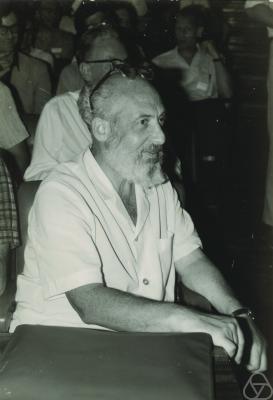- Samuel Eilenberg
Infobox Scientist
box_width =
name = Samuel Eilenberg
image_size =
caption = Samuel Eilenberg (1970)
birth_date = birth date|1913|9|30
birth_place =Warsaw ,Russian Empire
death_date = death date and age|1998|1|30|1913|9|30
death_place =
residence =
citizenship =
nationality =
ethnicity =
fields =
workplaces =Columbia University
alma_mater =Warsaw University
doctoral_advisor =Karol Borsuk
academic_advisors =
doctoral_students =
notable_students =
known_for =Eilenberg-Steenrod axioms Eilenberg swindle
author_abbrev_bot =
author_abbrev_zoo =
influences =
influenced =
awards =
religion =
footnotes =Samuel Eilenberg (
September 30 ,1913 —January 30 ,1998 ) was a Polish and Americanmathematician of Jewish descent. He was born inWarsaw ,Russian Empire (now inPoland ) and died inNew York City , USA, where he had spent much of his career as a professor atColumbia University .He earned his
Ph.D. fromWarsaw University in 1936. His thesis advisor wasKarol Borsuk . His main interest wasalgebraic topology . He worked on the axiomatic treatment ofhomology theory withNorman Steenrod (whose names theEilenberg-Steenrod axioms bear), and onhomological algebra withSaunders Mac Lane . In the process, Eilenberg and Mac Lane createdcategory theory .Eilenberg took part in the Bourbaki group meetings, and, with
Henri Cartan , wrote the 1956 book "Homological Algebra", which became a classic.Later in life he worked mainly in pure
category theory , being one of the founders of the field. TheEilenberg swindle (or "telescope") is a construction applying thetelescoping cancellation idea toprojective module s.Eilenberg also wrote an important book on
automata theory . TheX-machine , a form of automaton, was introduced by Eilenberg in 1974.elected publications
* Samuel Eilenberg, "Automata, Languages and Machines". ISBN 0-12-234001-9
* Samuel Eilenberg & Tudor Ganea, [http://links.jstor.org/sici?sici=0003-486X%28195705%292%3A65%3A3%3C517%3AOTLCOA%3E2.0.CO%3B2-J "On the Lusternik-Schnirelmann category of abstract groups"] , "Annals of Mathematics", 2nd Ser., 65 (1957), no. 3, 517 – 518. MathSciNet|id=0085510
* Samuel Eilenberg & Saunders Mac Lane, "Relations between homology and homotopy groups of spaces", "Annals of Mathematics " 46 (1945), 480–509.
* Samuel Eilenberg & Saunders Mac Lane, "Relations between homology and homotopy groups of spaces. II", Annals of Mathematics 51 (1950), 514–533.
*
* Samuel Eilenberg & Norman E. Steenrod, "Axiomatic approach to homology theory", Proc. Nat. Acad. Sci. U. S. A. 31, (1945). 117--120.
* Samuel Eilenberg & Norman E. Steenrod, "Foundations of algebraic topology",Princeton University Press , Princeton, New Jersey, 1952. xv+328 pp.ee also
*
Stefan Banach
*Stanisław Ulam
*Eilenberg-Ganea conjecture
*Eilenberg-MacLane space
*Eilenberg-Moore spectral sequence External links
*
*MacTutor Biography|id=Eilenberg
* [http://newton.nap.edu/html/biomems/seilenberg.html Eilenberg's biography] − from theNational Academies Press , byHyman Bass ,Henri Cartan ,Peter Freyd , Alex Heller andSaunders Mac Lane .Persondata
NAME= Eilenberg, Samuel
ALTERNATIVE NAMES=
SHORT DESCRIPTION=Polish-American mathematician
DATE OF BIRTH= 1913-9-30
PLACE OF BIRTH=Warsaw ,Russian Empire
DATE OF DEATH= 1998-1-30
PLACE OF DEATH=
Wikimedia Foundation. 2010.
